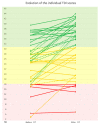Olfactory Training in Post-COVID-19 Persistent Olfactory Disorders: Value Normalization for Threshold but Not Identification
- PMID: 35743346
- PMCID: PMC9224948
- DOI: 10.3390/jcm11123275
Olfactory Training in Post-COVID-19 Persistent Olfactory Disorders: Value Normalization for Threshold but Not Identification
Abstract
(1) Background: Persistent post-viral olfactory disorders (PPVOD) are estimated at 30% of patients one year after COVID-19 infection. No treatment is, to date, significantly effective on PPVOD with the exception of olfactory training (OT). The main objective of this work was to evaluate OT efficiency on post-COVID-19 PPVOD. (2) Methods: Consecutive patients consulting to the ENT department with post-COVID-19 PPVOD were included after completing clinical examination, the complete Sniffin’ Stick Test (TDI), the short version of the Questionnaire of olfactory disorders and the SF-36. Patients were trained to practice a self-olfactory training with a dedicated olfactory training kit twice a day for 6 months before returning to undergo the same assessments. (3) Results: Forty-three patients were included and performed 3.5 months of OT in average. We observed a significant TDI score improvement, increasing from 24.7 (±8.9) before the OT to 30.9 (±9.8) (p < 0.001). Based on normative data, a significant increase in the number of normosmic participants was observed only for the threshold values (p < 0.001). Specific and general olfaction-related quality of life improved after the OT. (4) Conclusions: Olfactory function appeared to improve only in peripheral aspects of post-COVID-19 PPVOD after OT. Future controlled studies must be performed to confirm the OT role and justify new therapeutic strategies that may focus on the central aspects of post-COVID-19 PPVOD.
Keywords: COVID-19; olfaction disorders; olfactory training; parosmia.
Conflict of interest statement
The authors declare no conflict of interest.
Figures


Similar articles
-
Persistent COVID-19 parosmia and olfactory loss post olfactory training: randomized clinical trial comparing central and peripheral-acting therapeutics.Eur Arch Otorhinolaryngol. 2024 Jul;281(7):3671-3678. doi: 10.1007/s00405-024-08548-6. Epub 2024 Mar 16. Eur Arch Otorhinolaryngol. 2024. PMID: 38492007 Free PMC article. Clinical Trial.
-
Therapeutic options of post-COVID-19 related olfactory dysfunction: a systematic review and meta-analysis.Rhinology. 2023 Feb 1;61(1):2-11. doi: 10.4193/Rhin22.221. Rhinology. 2023. PMID: 36173148
-
A multicenter real-life study to determine the efficacy of corticosteroids and olfactory training in improving persistent COVID-19-related olfactory dysfunction.Laryngoscope Investig Otolaryngol. 2022 Dec 2;8(1):46-54. doi: 10.1002/lio2.989. Online ahead of print. Laryngoscope Investig Otolaryngol. 2022. PMID: 36718474 Free PMC article.
-
Olfactory Training Impacts Olfactory Dysfunction Induced by COVID-19: A Pilot Study.ORL J Otorhinolaryngol Relat Spec. 2023;85(2):57-66. doi: 10.1159/000528188. Epub 2022 Dec 16. ORL J Otorhinolaryngol Relat Spec. 2023. PMID: 36529118 Free PMC article. Clinical Trial.
-
Olfactory Training for Postviral Olfactory Dysfunction: Systematic Review and Meta-analysis.Otolaryngol Head Neck Surg. 2021 Feb;164(2):244-254. doi: 10.1177/0194599820943550. Epub 2020 Jul 14. Otolaryngol Head Neck Surg. 2021. PMID: 32660334
Cited by
-
Comparative Analysis of Olfactory and Gustatory Function of Patients With COVID-19 Olfactory Dysfunction and Non-COVID-19 Postinfectious Olfactory Dysfunction.J Korean Med Sci. 2023 Nov 6;38(43):e352. doi: 10.3346/jkms.2023.38.e352. J Korean Med Sci. 2023. PMID: 37935167 Free PMC article.
-
Persistent post-COVID-19 dysosmia: Practices survey of members of the French National Union of Otorhinolaryngology-Head and Neck Surgery Specialists. CROSS analysis.Eur Ann Otorhinolaryngol Head Neck Dis. 2023 Aug;140(4):159-163. doi: 10.1016/j.anorl.2023.04.002. Epub 2023 Apr 7. Eur Ann Otorhinolaryngol Head Neck Dis. 2023. PMID: 37087365 Free PMC article.
-
Maximizing Participation in Olfactory Training in a Sample with Post-COVID-19 Olfactory Loss.Brain Sci. 2024 Jul 21;14(7):730. doi: 10.3390/brainsci14070730. Brain Sci. 2024. PMID: 39061470 Free PMC article.
-
Long COVID, the Brain, Nerves, and Cognitive Function.Neurol Int. 2023 Jul 6;15(3):821-841. doi: 10.3390/neurolint15030052. Neurol Int. 2023. PMID: 37489358 Free PMC article. Review.
-
Treatments for Olfactory Dysfunction in COVID-19: A Systematic Review.Int Arch Otorhinolaryngol. 2024 May 25;28(4):e728-e743. doi: 10.1055/s-0044-1786046. eCollection 2024 Oct. Int Arch Otorhinolaryngol. 2024. PMID: 39464360 Free PMC article. Review.
References
-
- Riestra-Ayora J., Yanes-Diaz J., Esteban-Sanchez J., Vaduva C., Molina-Quiros C., Larran-Jimenez A., Martin-Sanz E. Long-Term Follow-up of Olfactory and Gustatory Dysfunction in COVID-19: 6 Months Case—Control Study of Health Workers. Eur. Arch. Oto-Rhino-Laryngol. 2021;278:4831–4837. doi: 10.1007/s00405-021-06764-y. - DOI - PMC - PubMed
-
- Boscolo-Rizzo P., Guida F., Polesel J., Marcuzzo A.V., Antonucci P., Capriotti V., Sacchet E., Cragnolini F., D’Alessandro A., Zanelli E., et al. Self-Reported Smell and Taste Recovery in Coronavirus Disease 2019 Patients: A One-Year Prospective Study. Eur. Arch. Oto-Rhino-Laryngol. 2022;279:515–520. doi: 10.1007/s00405-021-06839-w. - DOI - PMC - PubMed
-
- Lechien J.R., Chiesa-Estomba C.M., Beckers E., Mustin V., Ducarme M., Journe F., Marchant A., Jouffe L., Barillari M.R., Cammaroto G., et al. Prevalence and 6-Month Recovery of Olfactory Dysfunction: A Multicentre Study of 1363 COVID-19 Patients. J. Intern. Med. 2021;290:451–461. doi: 10.1111/joim.13209. - DOI - PubMed
LinkOut - more resources
Full Text Sources
Research Materials
Miscellaneous

